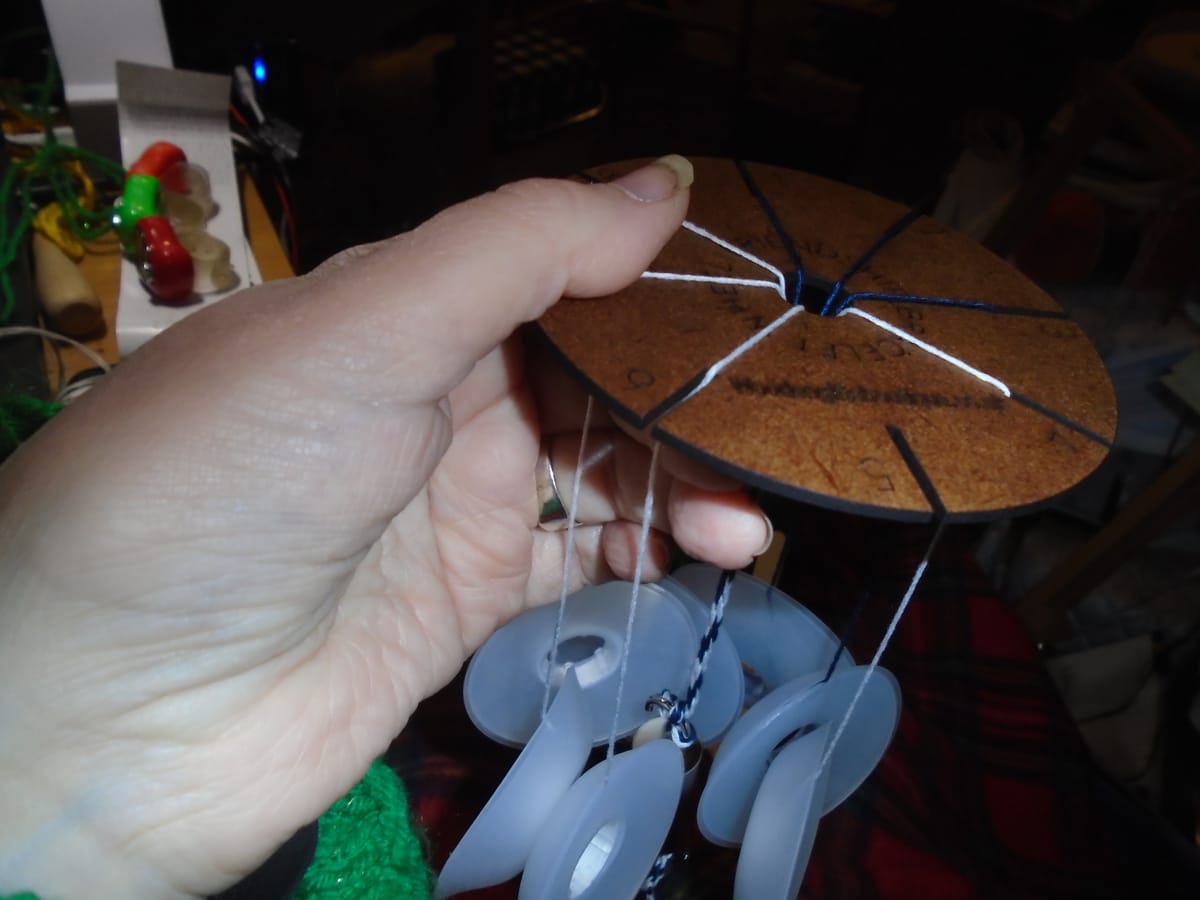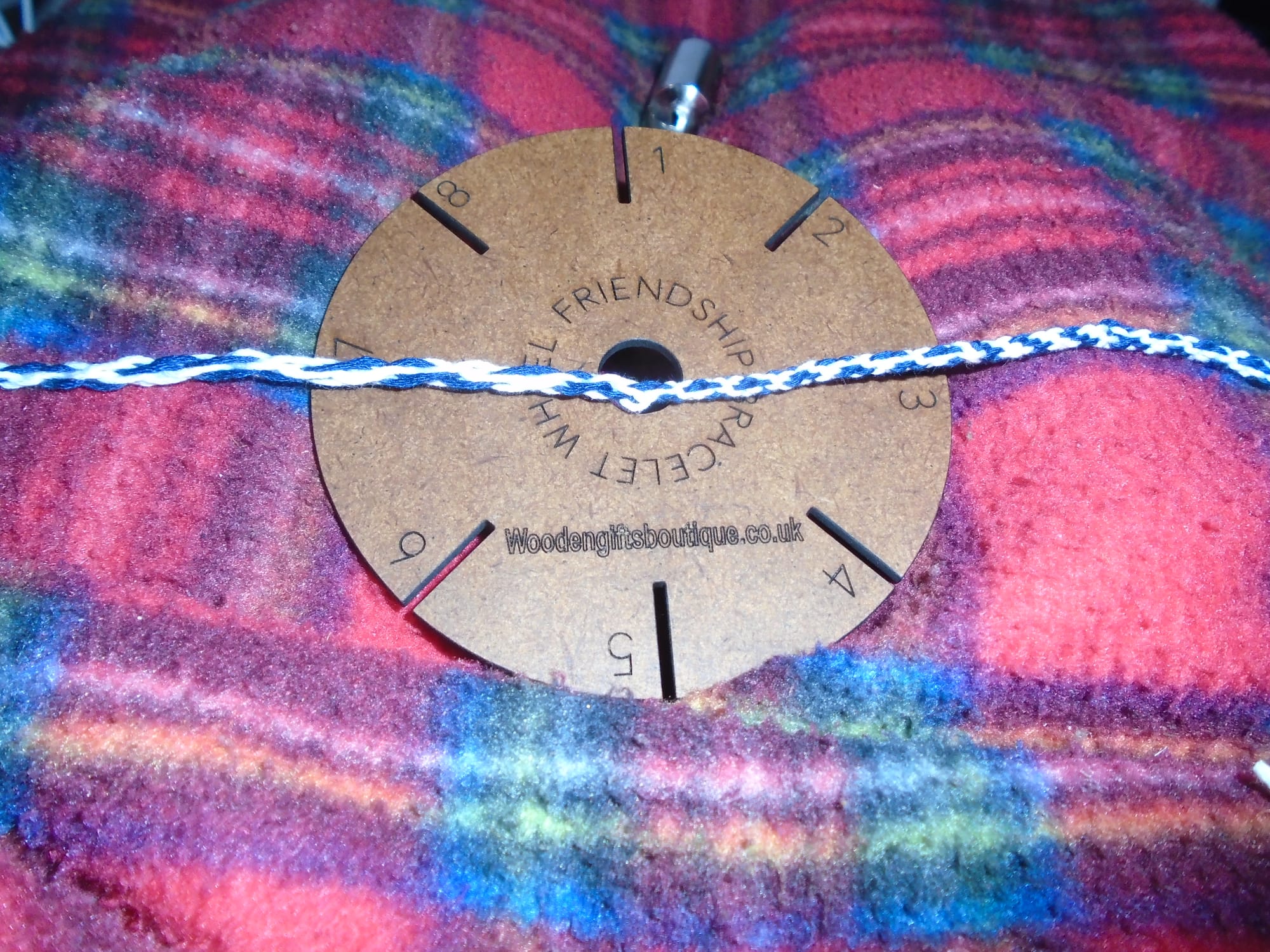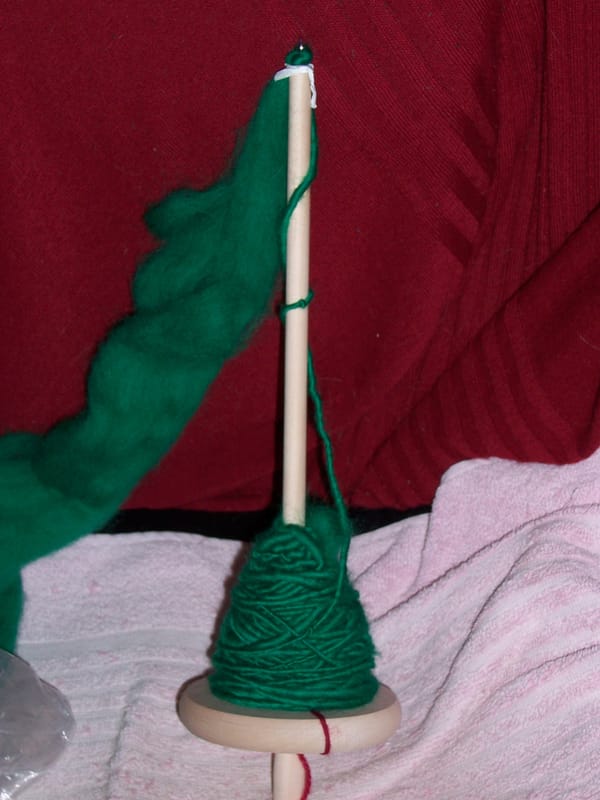Modified rapture

Along with the new lucet, I also ordered what they called a "friendship bracelet wheel". They both came from a company called Wooden Gifts Boutique, who have a website address etched on the wheel, but in fact it redirects to their eBay shop, so I imagine the website is now defunct. This thing was obviously a species of kumihimo disc, and so I was intrigued. My regular kumihimo disc is made of foam, so not that pleasant to handle, but it has 32 slots and this has only 8. I wondered how it was going to work. If nothing else, it had to be nicer to handle than the foam one.
Well, it is; but I'm not so sure about it as an actual kumihimo disc. With standard kumihimo, you cross the threads over in pairs, so you always use an even number of threads; this makes it nice and simple when you're starting off, because you cut half the number of threads you need at twice the length, then you fold them in half and knot them near the middle, which means you've automatically got a nice little loop to hang your weight on. But this one... it's a braiding technique on a disc, so I should think it still counts as kumihimo, but it's not the standard version. This makes a seven-stranded braid. I have nothing at all against a seven-stranded braid, and you can get some rather pretty effects using two colours, but it's not what I'm used to. (And, for the curious, what you're doing to get that braid is crossing over two threads at a time. The slots are numbered 1-8 clockwise; to start with, you have a thread in each slot apart from number 1. You then cross the thread in slot 4 over 3 and 2, put it in slot 1, and rotate the disc so that slot 4 is now at the top. Cross the thread in slot 7 over 5 and 6, put it in slot 4, and rotate so that slot 7 is at the top. And so on like that.)
Being used to standard kumihimo, I used my bobbins and weight, as you see in the photo. The bobbins were a good idea; they always are. They are specially designed so that the edges grip the thread gently, so you can pull out a little at a time and the whole bobbin doesn't unwind. They save a good deal of tangling and concomitant annoyance. The weight, on the other hand, was not. A wooden disc with fairly wide slots relative to the thread (the slots are wide enough to take the finished cord, in fact; I checked) does not have the high degree of friction that a foam disc has. It has some, so the weight didn't pull all the bobbins up and onto the disc, but it meant that the top of the cord being made was a little way below the base of the disc, and so the braiding turned out quite loose. After a while I took the weight off, at which point the braid tightened up quite dramatically, as you see here:

I don't know about friendship bracelets, but this type of braid will definitely make some funky shoelaces. Without the weight, obviously. And it's strange, because this behaviour is pretty much exactly the opposite of a foam disc. On a foam disc, the friction is so great that if you don't weight the cord it will go all out of shape.
Oh, and you can't see the grain in the photo. Neither could I, when I first looked at it; then I looked a bit more closely and saw... a pattern of fine scratch lines running horizontally across the disc (as you see it in the photo above). For a moment I thought I'd been doing them an injustice in thinking it was actually MDF. Then I realised that the lines were far too even to be real wood grain, there weren't any colour variations to go with them (as you would normally get with wood), and if you hold the thing in the light at a slight angle - which is what's going on in the photo, in fact - what you see is that very slight non-directional mottling you get with MDF. So MDF is in fact what it is, but they've tried to get it up to look like wood. I wouldn't have minded paying that much for wood, but since it is MDF I feel I've been rather heavily overcharged. The lucet's definitely proper wood, though.
The overall verdict? Meh. It'll have its uses (and just the fact that it makes a different kind of braid from normal kumihimo is a bit of a plus), but I'm disappointed it's not wood, given that it was sold to me by a company claiming to specialise in wooden gifts and they charged me the price you'd expect for wood. (Don't get me wrong; I don't mind MDF as a matter of general principle, especially not if it's laser-cut, as this is. But I do like to be clearly told that's what I'm getting.) And the lack of friction is a problem; I now know I can get round it by not using the weight while the device is in use, but it does make it very difficult to park when it isn't, as the threads tend to slip out of the slots. (This explains why the pattern changes a couple of times on the right-hand side of my sample cord. I had to put it down a few times, and I clearly didn't always get the threads back into the correct slots.) That, in turn, means it's not really portable at the moment, at least until I think of some way to secure it when not in use, which is probably going to involve clipping or tying the threads underneath the disc in some way.
Oh well. You live and learn!




